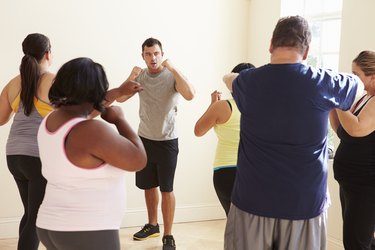
Obesity can contribute to conditions such as degenerative disc disease and spinal stenosis. Both are factors in sciatica – pain in the lower back, leg and hip. Exercise can reduce the risk of obesity-related disease and facilitate weight loss. Obese individuals with leg pain often have difficulty exercising, but simple modifications can relieve pressure on the joints. Consult your physician before starting any exercise program.
Strength Training Exercises
Video of the Day
Strength training can help relieve leg pain by strengthening the muscles that support the joints and stabilize the spine. Additionally, building muscle mass increases the resting metabolism and contributes to weight loss. Obese individuals with leg pain should avoid doing standing body-weight exercises, such as squats and lunges, as these can put additional stress on the joints. Gym machines, such as the leg press, leg extension and leg curl allow you to work seated until your muscles and joints are strong enough to support body-weight exercises. You may also benefit from seated or reclining body-weight exercises, such as triceps dips, crunches and push-ups.
Video of the Day
Aerobic Exercises
Aerobic exercise improves blood flow and helps with weight loss by temporarily increasing the metabolism. Unfortunately, weight-bearing aerobic exercises, such as running or walking, can aggravate leg pain. Many weight-bearing aerobic exercises can also be done in the water. Swimming laps is both aerobic and provides a degree of strength training as you need to work all the major muscles in your arms, legs and torso to move through the water. With water aerobics and water running, the natural buoyancy supports much of your body weight to allow you perform higher-impact activities. If you prefer land activities, seated aerobic exercises, such as stationary bicycles, raise your heart rate with less strain on the joints. For those with mild pain, walking, whether outside or on a treadmill, is a relatively safe activity.
Stretching Exercises
Stretching helps maintain mobility and range of motion in the joints. There are many stretches available and the only limitation is your own flexibility and level of leg pain. Additionally, yoga provides several modifications and variations depending on your physical limitations. For example, a forward bend stretching from the lower back to the calves can be done either standing or seated on the floor or a chair. Yoga has supine back bends, such as the cobra, sphinx and upward facing dog, kneeling back bends, such as the camel, and several standing back bends, including the crescent pose. The Arthritis Foundation recommends stretching all major muscle groups several times a week. Consider restorative or yin yoga classes, which focus on holding comfortable poses for long periods of time.
- Arthritis Foundation: Introduction to Exercise
- Spine Universe: Back Pain and Obesity
- Johns Hopkins Arthritis Center: Osteoarthritis Weight Management
- Diabetes In Control: Seated Exercise Series – Chair Aerobics
- Diabetes In Control: Seated Exercises – Chair Calisthenics
- "Arthritis Today": Water Walking 101
- "Yoga Journal": Leg Poses
- "Yoga Journal": Lower Back Poses